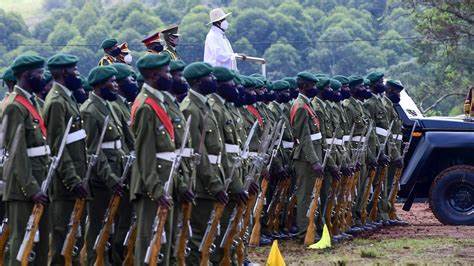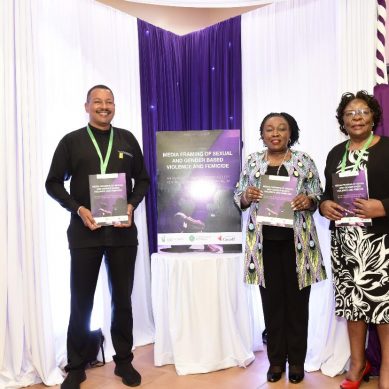
In my recent article ‘Rethinking the environment for effective environmental management and conservation of Uganda’s diverse ecologies’, I emphasised that the environment should be viewed as consisting of four interlinked, dynamically interacting dimensions: ecological-biological, socio-economic, sociocultural and temporal.
When the dimensions experience decay and collapse, war and the phenomenon of environmental refugees predominate in the environment.
Humanity generally depends on muscle and gun more than thinking, reasoning and negotiation of relationships and interactions. It is much easier for rulers and leaders to declare wars than negotiations to resolve conflicts. In some cases, the wars result in one country invading, occupying and annexing another. It is conflicts, frequently armed, that are responsible for generating environmental refugees and/or one country or groups of people occupying another country and dominating the people therein.
There are many consequences of military occupation of one country by another. The occupation may be short-term, medium-term or long-term. If the occupation results in annexation, the owners of the annexed country may never recover their ownership of the country, their sovereignty and their citizenship from the occupiers. They may even be degraded into secondary or tertiary citizens or reduced to slaves in their own country. There are many Ugandans who think, believe and are convinced that their country was not liberated, as those who captured the instruments of power in 1986 by the gun, have propagandised, preached and continue to celebrate at great cost to the taxpayers, but invaded and occupied the country.
The thinking, belief and conviction arises from the fact the invading forces were predominated by Tutsi elements from Rwanda and Mulenge of the Democratic Republic of Congo (DRC) who originally organised as Front for National Salvation (FRONASA), then as Patriotic Resistance Army (PRA), then consumated Yusuf Lule’s idea of National Resistance Movement/Army after Lule agreed to merge his Freedom Fighters of Uganda (FFU) and Yoweri Tibuhaburwa Museveni’s PRA to concretise his idea of NRM/A during a meeting at Mboijana’s residence in Kabete, Kenya in in August 1981.Indeed today, there is little evidence that the neo-traditionalist innovators of NRM/A hold any significant positions in the NRM or Army.
The fact that the leadership of NRM and army is strongly in the hands of the people who belonged to FRONASA and PRA and the exacerbated ethnic nepotism now dominating Uganda have increasingly made many Ugandans accept that their country is politically and militarily occupied, with serious impacts on the environment, ecology, culture, economy, education, health, et cetera.
Military occupation of a country indeed has many consequences. In this article I assume that the insurgency between 1981 and 1986 was not a liberation of Ugandans but an invasion that ultimately resulted in occupation of Uganda by foreign-dominated forces of mostly refugees and former refugees posing as nationalists and citizens of the country.
The insertion of a category of ostensibly indigenous Ugandans in the Uganda Constitution 1995 called Banyarwanda generated a lot of suspicion since the constitution-making process was firmly under the control and influence of refugees and former refugees. These used the constitution to legitimise their rule and enhance their influence in every sphere of life in the country. They created a sociopolitical and politico military environment in the Great Lakes Region in general and Uganda in particular and a legal framework that was conducive for more and more refugees to flock into the country from mainly the Cushite dominated countries (Burundi, Somalia, Rwanda, Eritrea and Ethiopia).
Some have come from the Karagwe area of Tanzania where there is a sizeable population of nomadic pastoralists. The country now has over 1.74 million refugees, the largest refugee population in Africa. The majority of refugees come from South Sudan (55 per cent) and the Democratic Republic of the Congo, mainly Mulenge area, of Rwandese nomadic pastoralists called Banyamulenge (31 per cent).
Uganda is well known as a strong refugee protector, but faces a number of socio-economic and governing challenges, as well as complex political priorities and relationships. Based on their research on the political stakes of refugee protection in Uganda, Ronald Kalyango Sebba and Franzisca Zanker (2022) found many political stakes:
- A number of refugees are self-settled in urban areas, resulting in practical struggles such as police harassment, limited access to healthcare, jobs, livelihood opportunities and vocational training programmes.
- Institutionally, refugee governance in Uganda is constrained by highly centralszed decision-making and underfunding of refugee hosting districts.
- Settlement-based land policies limit refugee choice and have been difficult to sustain due to growing numbers of refugees and growing tensions with host communities.
- The development approach avoids any potential political integration of refugees
Besides, many indigenes of Uganda think, believe and are convinced that refugees and former refugees now predominate in all kinds of leadership and governance; that they conceal themselves as Ugandans under dual citizenship effectively outcompeting the indigenes for opportunities. Some have been in the executive, legislature and judiciary. There are fears among the indigenes that NRM government is plotting to grant all Cushite refugees in the country citizenship. For Rwandan refugees, it is much easier under the auspices of the constitutionally recognised “indigenous group of Banyarwanda”, which many Ugandans fear was created as a conduit for many Rwandan to enter Uganda and become citizens and nationals.
There is widespread belief that the majority of land grabbers come directly from Rwanda and Mulenge in the Democratic Republic of Congo. Previously nomadic-pastoralist refugees would come from those places across the Ugandan border would come with the cattle, stay for a short time and then go back. However, these days they come with cattle and gun on their laps, stay and permanently settle as modern-day land owners.
Environmentality, an approach to understanding complex interplays of power in environmental governance of human-environment interactions, has changed. So has governmentality, the exercise of organised political power by a nation or state (see also nation-state) and expands it to include the active consent and willingness of individuals to participate in their own governance, has also changed as a result of the rising predominance of refugees and former refugees in governance and leadership, with the decline of the negotiated approach and rise of the command-and obey approach to governance and leadership of/in Uganda to favour refugees and former refugees.
Since the late 1990s environmentality, also labelled “environmental governmentality,” “eco-governmentality” and “green governmentality” has been applied to various environmental contexts, such as forestry and natural resource management (Agrawal 2005; Shaunna Barnhart, 2016). More recently, environmentality and governmentality have been used in discard studies to explore power dynamics and changing attitudes and actions regarding waste, waste disposal and waste governance specifically (Leonard 2013; Moore 2012; Shaunna Barnhart, 2016) and as a way to explore changing environmental identities and actions broadly, including those related to waste (Harris 2011; Shaunna Barnhart, 2016).
One truism is that refugees can end up capturing the instruments of power, occupying, penetrating and perennially governing their country of refuge. This happened in South Africa for many decades until finally apartheid collapsed in the very early 1990s. In New Zealand, Australia and the Americas, the Maoris, Aboriginals and the Red Indians completely lost their land and countries to the invading Caucasians from Europe respectively. The new arrivals captured every aspect of their new lands of abode, penetrated and interoperated them and rendered the indigenes landless and almost like environmental, ecological, cultural and social pollutants.
When a country is invaded and occupied for a long time, it will be penetrated in diverse ways. In the context of this article, I identify the following penetrations of the area that came to be called Uganda: military penetration, spiritual penetration, capitalism penetration, capitalist penetration, neoliberal penetration, environmental penetration, ecological penetration, intellectual penetration, ethical penetration, genetic penetration, moral penetration, academic penetration, cultural penetration, market penetration, Indian penetration and Chinese penetration.
I have no time and space to discuss each of the different types of penetration. However, they are good themes for researchers who want to know to what extent Uganda has been penetrated in the last 38 years under Chwezi-Cushite rule and influence.
Suffice to say a bit about two types of penetration that the rulers of Uganda in the last 38 years have sought to popularise as a way of life for all in the country:
- Capitalist penetration is a concept that refers to the extent to which capitalism has penetrated a particular area. Weak capitalist penetration can lead to violent exploitation, especially of people who are not directly involved in capitalist production.
- Neoliberal penetration of the country has exacted enormous influence on the country. With the rise of neoliberalism all of society is increasingly dominated and penetrated by a capitalist logic that transforms every aspect of life into a commodity and leads to asymmetrical power relations domestically and internationally.
Introduction
The country called Uganda today was originally composed of numerous traditional nationalities that mostly lived in harmony with each other. These were Acholi, Ankole, Buganda, Bugisu, Bukedi, Bunyoro, Busoga, Karamoja, Kigezi, Lango, Moyo, Sebei, Teso, Toro and West Nile. Their relative tranquillity and peace were perturbed by militarised people from beyond present-day Northern and present-day East of Uganda, with both beneficial and dire consequences.
Thesis statement
The thesis statement of this article is:
“Uganda was militarily invaded in 1981 by a combined force of refugees and former refugees who ultimately occupied, penetrated and effectively expelled the indigenes from most civic spaces, the army, police, prisons and intelligence services with serious consequences”.
British invasions, conquests, occupations, penetrations: The consequences
The British colonialists occupied it and began to weave it into one centralised country, which they first called British Uganda Protectorate, and then Common Wealth Realm of Uganda and finally Uganda. The British introduced a centralised government with executive, legislative and judicial arms. They exacerbated the districtisation of their new sphere of influence, preserved hereditary kingdoms of Buganda, Bunyoro, Toro and Ankole and introduced sugarcane and cotton as cash crops, while also raising coffee, which they found being grown in the Lake Victoria Region, into a cash crop as well. Hey penetrated the whole area militarily, politically, culturally, economically and socially. They introduced centralised health system and education system as well and initiated urbanisation.
Long before the arrival of the British, other conquests, occupations and penetrations had occurred: the Batembuzi conquests, occupations and penetrations; the Chwezi-Cushite conquests, occupations and penetrations and the Luo Babiito conquests, occupations and penetrations.
Emin Pasha, Nubian penetrations and Nubianisation: The consequences
Let me begin with Emin Pasha and his Nubian soldiers. Mehmed Emin Pasha (born Isaak Eduard Schnitzer, baptised Eduard Carl Oscar Theodor Schnitzer; March 28, 1840 – October 23, 1892) was an Ottoman physician of German Jewish origin, naturalist and governor of the Egyptian province of Equatoria on the Upper Nile. The Ottoman Empire conferred the title “Pasha” on him in 1886 and thereafter he was referred to as “Emin Pasha”
The introduction of sleeping sickness in Uganda was attributed to the movement of Emin Pasha and his followers. Prior to the 1890s, sleeping sickness was unknown in Uganda, but the tsetse fly was probably brought by Emin from the Congo territory.
Emin Pasha was an enlightened administrator who ended slavery in the region and established a lasting administration that survived for over 70 years. In 1878 he became governor of Equatorial Province in Uganda, which had been established by its first governor, Samuel Baker in 1870, and Charles George Gordon took over as governor in 1874. He added greatly to the anthropological knowledge of central Africa and published valuable geographical papers. Thus, he contributed greatly to the accumulating scientific knowledge in the Great Lakes region. In 1890 he was awarded the Founder’s Medal of the Royal Geographical Society.
According to intelligence reports under the British East African Company Emin Pasha accumulated ivory stocks of 75000 kilogrammes worth 100,000 British pounds, which was a lot of money then. One can say he exploited his position to accumulate wealth. I did not find evidence that he was shooting elephants during his movements. However, many historians cast Emin Pasha as organiser rather than conqueror. He strongly opposed Black slave trade and urged removal of Arab black slavers from the Continent of Africa. He contributed considerably to African natural history, ethnography and language (Mustafa Efe, 2016). Besides he established the state in the modern sense; showed that close relations with the people of the region was essential to fight black slave trade; and demonstrated that scientific work can be done along with statesmanship in Africa.
In 1911, after Emin Pasha’s relief mission, some of his Nubian soldiers remained in Tanzania, while others were brought back to Uganda by Captain Frederick Lugard. The Nubians that integrated in the West Nile region of Uganda spread Islam there (Daily Monitor, 2012).
Focusing on the period 1894 to 1995 and drawing on both written and oral sources, Mahajubu, Balunywa and Musisi (2019) explored the origin, ethnic identity and settlement of the Nubians since their advent in Uganda. Ugandan Nubians abandoned some aspects of their former African traditional customs and adopted new ones borrowed from the Arabic culture, constituting a unique and distinct ethnic group. They articulated the fluidity and formation of the Nubian ethnic identity on one hand, and the strategies that the Nubians have used to define and sustain themselves as a distinct ethnic group in Uganda. They suggested that the question of the Nubian identity in Uganda, through tracing their origin, ethnic identity and settlement since their advent, goes beyond the primordial understanding of ethnicity that tags ancestral location or settlement pattern, language, family history to a particular group claiming itself ethnic.
According to Mahajubu, Balunywa and Musisi (2019), on arrival in Uganda, the Nubians settled among the Acholi, Madi and Lugbara and formed the Nubi/Madi, Lugbara and Acholi Nubi ethnicity. The said tribes adopted the Nubi culture, practice and social structures. They wrote that the Aringa, Kuku, Pojulu, Nyepo, Liggi tribes adopted the Nubi culture and tradition, thus becoming ethnicised; and that the same was true with the Nubis in the Buganda Kingdom. Many Baganda adopted the Nubi way of life, intermarried with them and some even adopted the Nubi religion (Islam).
Citing Rowe (1988: 273) Mahajubu, Balunywa and Musisi (2019). State thus: “Ganda Muslims were looked down upon by everyone else and their strange manner of Nubian Arab dressing (turbans and Tarbushes). This suggests that some Baganda Muslims were Nubianised.
Mahajubu, Balunywa and Musisi (2019) write that in 1890s, Emin Pasha brought the Nubian soldiers to Kampala and settled them in the capital of Buganda Kingdom and other parts like Kololo, after the death of one Charles Gordon. On the way to Buganda and Bunyoro, Emin Pasha recruited several people from the different tribes of Madi, Alur, Acholi, Kakwa from the West Nile districts of Northern Uganda. Such recruitments did not only convert the Ugandans into Muslims, but a Nubi ethnic category. Citing Nakayi (2007: 26) Mahajubu, Balunywa and Musisi (2019) state that all these recruits later formed part of the Nubian contingents that remained in Uganda, intermarried, multiplied in number and it became impractical for the colonial administration to repatriate them to their country of origin – Sudan. Some Baganda embraced the Nubi methods of work, culture and practice. This was because some of them adopted the special Islamic brand of the Nubis.
For God and my country
- A Tell report / By Oweyegha-Afunaduula / Environmental Historian and Conservationist Centre for Critical Thinking and Alternative Analysis (CCTAA), Seeta, Mukono, Uganda.
About the Centre for Critical Thinking and Alternative Analysis (CCTAA)
The CCTAA was innovated by Hyuha Mukwanason, Oweyegha-Afunaduula and Mahir Balunywa in 2019 to the rising decline in the capacity of graduates in Uganda and beyond to engage in critical thinking and reason coherently besides excellence in academics and academic production. The three scholars were convinced that after academic achievement the world outside the ivory tower needed graduates that can think critically and reason coherently towards making society and the environment better for human gratification. They reasoned between themselves and reached the conclusion that disciplinary education did not only narrow the thinking and reasoning of those exposed to it but restricted the opportunity to excel in critical thinking and reasoning, which are the ultimate aim of education. They were dismayed by the truism that the products of disciplinary education find it difficult to tick outside the boundaries of their disciplines; that when they provide solutions to problems that do not recognise the artificial boundaries between knowledges, their solutions become the new problems. They decided that the answer was a new and different medium of learning and innovating, which they characterised as “The Centre for Critical Thinking and Alternative Analysis” (CCTAA).
Abdul Mahajubu, Balunywa M and Musisi F (2019). We did not come as mercenaries: Linking the origin, ethnic identity and settlement of the Nubis in Uganda. Academic Journals, Vol.11(3), pp. 26-34, March 2019
Akankwatsa Andrew Oba (2024). Mysteries of Bunyoro Kitara: A deep Dive into the Batembuzi and Bachwezi Dynasties. Remedial Corner, https://remedialcorner.com/blog/mysteries-of-bunyoro-kitara-a-deep-dive-into-the-batembuzi-and-bachwezi-dynasties/#:~:text=The%20Batembuzi%20were%20a%20legendary,Uganda%2C%20Rwanda%2C%20and%20Tanzania. Visited on 30 November 2024 at 16.33pm EAT
Arun Agrawal (2005). Environmentality. Current Anthropology Vol, pp. 161-190 (30 pages). Published By: The University of Chicago Press. https://www.jstor.org/stable/10.1086/427122 Visited on 29 November 2024 at 11.24 am EAT
Chen, M., Tang, Y., Ning, D. (2013). Penetration of Moral Quality Education on University Life Sciences Courses Teaching. In: Du, W. (eds) Informatics and Management Science VI. Lecture Notes in Electrical Engineering, vol 209. Springer, London. https://doi.org/10.1007/978-1-4471-4805-0_58
Clegg, S. (2019). Governmentality. Project Management Journal, 50(3), 266-270. https://doi.org/10.1177/8756972819841260
Daily Monitor (2012). Emin Pasha’s Nubian soldiers Spread Islam in West Nile. Daily Monitor, September 4 2012. https://www.monitor.co.ug/uganda/lifestyle/reviews-profiles/emin-pasha-s-nubian-soldiers-spread-islam-in-west-nile-1524882 Visited on 5 December 2024 at 9.51 am EAT.
Foster Byarugaba and F.C. Oweyegha-Afunaduula (1995). Environmental Impacts of Refugees in Africa: Some Suggestions for Future Actions. Department of Political Science and Public Administration, Makerere University (Publisher: 1995. https://books.google.co.ug/books/about/Environmental_Impact_of_Refugees_in_Afri.html?id=RM8wPwAACAAJ&redir_esc=y Visited on 29 November 2024 at 13 43 pm EAT
Gewirth, Alan (1962). Intellectual penetration and moral sensitivity. Chicago Daily Tribune (1923-1963), 14 Jan 1962: d10. ProQuest, https://www.proquest.com/docview/183096211?sourcetype=Historical%20Newspapers Visited 30 November 2024 at 10.56am EAT
Kang, L., Wang, C. C., Chen, F., Yao, D., Jin, L., & Li, H. (2014). Northward genetic penetration across the Himalayas viewed from Sherpa people. Mitochondrial DNA Part A, 27(1), 342–349. https://doi.org/10.3109/19401736.2014.895986, https://www.tandfonline.com/doi/full/10.3109/19401736.2014.895986?scroll=top&needAccess=true Visited on 4 December 2024 at 11.37am EAT
Laird, S. et.al. (2022). Social and environmental transformation of refugee and hosting community in Central and Eastern Africa. Occasional Paper No. 229. Center for International Forestry Research (CIFOR). https://dir.muni.ac.ug:8443/server/api/core/bitstreams/1edfde7b-9c5d-4dfa-bbc6-0983f10fdcac/content Visited on 29 November 2024 at 12.58 pm EAT.
Martin, Adrian (2005). Environmental Conflict Between Refugees and Host Communities. Journal of Peace Research, vol. 42, no. 3, 2005, pp. 329–346 Sage Publications (London, Thousand Oaks, CA and New Delhi) http://jpr.sagepub.com DOI 10.1177/0022343305052015, https://www.projectgaia.com/files/EnvironmentalConflictRefugeesHostCommunities.pdf Visited on 29 November 2024 at 13.09 pm EAT.
Mazrui A.A (1977). Religious Strangers in Uganda: From Emin Pasha to Amin Dada. African affairs 76(302):21-38.
Muller, B. (2017, November 30). Governmentality and Biopolitics. Oxford Research Encyclopedia of International Studies. Retrieved 29 Nov. 2024, from https://oxfordre.com/internationalstudies/view/10.1093/acrefore/9780190846626.001.0001/acrefore-9780190846626-e-50.
Mustafa Efe (2016). Emin Pasha’s Role in Africa. New Vision January 1 2016. https://www.newvision.co.ug/news/1425956/emin-pasha-role-africa Visited on 5 December 2024 at 9.20 am EAT
Oweyegha-Afunaduula (2024). History of Uganda’s Political Leadership: From 1894 to the Present. Penguin Publishers STILL IN PRESS
Oweyegha-Afunaduula (2024). The Threat of Political Ethnization. Ultimate News, January 11 2024, https://ultimatenews.co.ug/2024/01/oweyegha-afunaduula-the-threat-of-political-ethnicization-of-uganda/ Visited on 27 November 2024 at 16.24pm EAT.
Oweyegha-Afunaduula (2024). The Military Capture of Uganda’s Civic Space Yesterday and Today. https://ugandatoday.co.ug/the-military-capture-of-ugandas-civic-space-yesterday-and-today/ Visited on 27 November 2024 at 16.29pm EAT.
Oweyegha-Afunaduula (2024). The role of rulers in institutionalised Violence in Africa. Te Kamapala Report, May 4, 2023 https://www.thekampalareport.com/talk-back/2023050426367/oweyegha-afunaduula-the-role-of-african-rulers-in-institutionalized-violence-in-africa.html Visited on 27 November 2024 at 16.35pm EAT.
Oweyegha-Afunaduula (2024). Chwezi-Cushite Effect on Traditions, Culture, Spirituality and Political Development of Busoga. Center for Critical Thinking and Alternative Analysis (CCTAA), Seeta, Mukono, Uganda.
Oweyegha-Afunaduula (2023). The root cause of Violence in Uganda and Great Lakes region. Ultimate News, March 28, 2023 https://ultimatenews.co.ug/2023/03/oweyegha-afunaduula-root-causes-of-violence-in-uganda-and-the-great-lakes-region/ Visited on 27 November 2024 at 16.43pm EAT
Oweyegha-Afunaduula (2023). Bigmanity, the sterile culture of money and violence in Africa: the case of Uganda. Ultimate News, June 23, 2023 https://ultimatenews.co.ug/2023/06/oweyegha-afunaduula-bigmanity-the-sterile-culture-of-money-and-violence-in-africa-the-case-of-uganda/ Visited on 27 November 2024 at 16.38pm EAT
Oweyegha-Afunaduula (2023). Linking Environmentality and Governmentality in Environmental Management and Conservation in Africa: Uganda in Perspective. The Kampala Report, June 27, 2023. https://www.thekampalareport.com/talk-back/op-ed/2023062728343/linking-environmentality-and-governmentality-in-environmental-management-and-conservation-in-africa-uganda-in-perspective.html Visited on 29 November 2024 at 12.49 pm EAT
Oweyegha-Afunaduula (2022). Disappearance of Police in Uganda Police. Daily Monitor, February 11 2022. https://www.monitor.co.ug/uganda/news/insight/disappearance-of-police-in-uganda-police-the-dangers-3713354 Visited on 27 November 2024 at 16.20pm EAT.
Ronald Kalyango Sebba & Franzisca Zanker (2022). August 2022. Political Stakes of Refugee Protection in Uganda https://www.arnold-bergstraesser.de/sites/default/files/political_stakes_of_refugee_protection_in_uganda_sebba_zanker.pdf Visited on 29 November 2024 at 13.23 pm EAT
Shaunna Barnhart (2016). Environmentality. https://discardstudies.com/2016/07/27/environmentality/ visited on 29 November, 2024 at 11.52am EAT.
Thalif Deen (2017). Should Environmental Refugees be granted Asylum Status? ReliefWeb, 30 November 2017, https://reliefweb.int/report/world/should-environmental-refugees-be-granted-asylum-status Visited on 29 November 2024 at 13. 17pm EAT.
Ulrich Bröckling, Susanne Krasmann, Thomas Lemke (2011). Governmentality, Current Issues and Future Challenges. Routledge. https://www.routledge.com/Governmentality-Current-Issues-and-Future-Challenges/Brockling-Krasmann-Lemke/p/book/9780415811422?srsltid=AfmBOooPnTC1YVQ_EX3zISDRDBUTLuscgPQzr3uzGpsS4QJdafodMhw5 Visited on 29 November 2024 at 12.43pm EAT
Walters, Williams (2012). Governmentality Critical Encounters. Routledge, Published June 7, 2012 https://www.routledge.com/Governmentality-Critical-Encounters/Walters/p/book/9780415779548?srsltid=AfmBOop-ntEZrd17LS9NIWTycgp9ht_jhGCPcGxxlaUVx10gD7e8COc2 Visited on 29 November 2024 at 12.27am EAT







